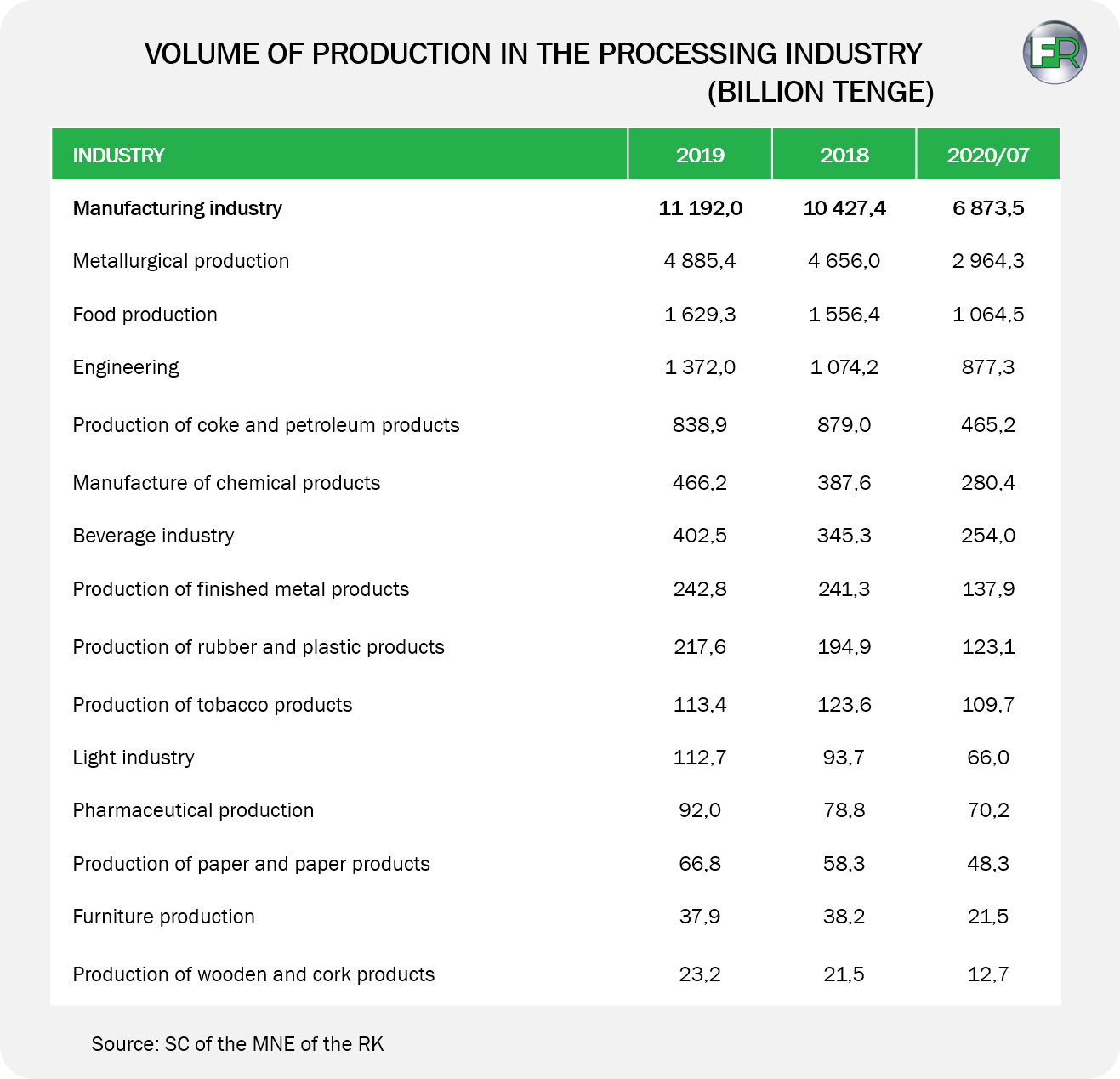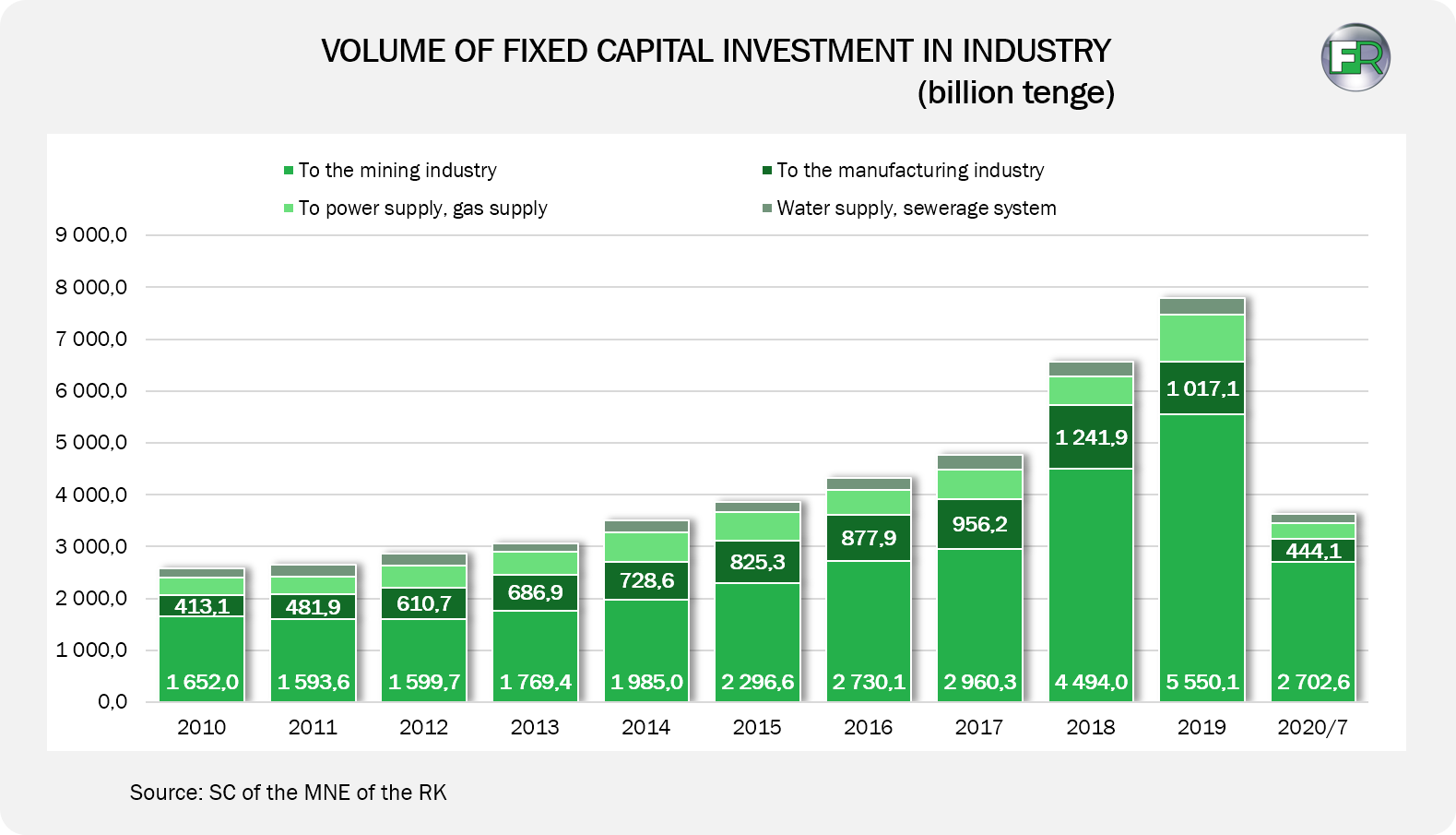The world economy has entered the post-industrial era, when economic growth depends directly on innovative technologies and services with high added value. Nevertheless, the stability of the Kazakh economy is still provided by the industrial sector. Read about the development of industrialization in the country and what effect it has on the national economy in the analytical material FinReview.info.
2019 was the final stage of implementation of the second industrial five-year plan. During this time, a new production base was launched in Kazakhstan, which allowed to ensure productive employment and economic stability in the country’s regions. Thus, since 2015, industrial enterprises have produced products worth 113.3 trillion tenge. Labor productivity in the industry reached 67.4 million tenge per person. At the same time, the inflow of investments in fixed assets for five years amounted to more than 27.3 trillion tenge.
Today, Kazakhstan has such large multinational companies as Kazchrom, KSP Steel, Alstom, General Electric, BASF, and others. Over the past five years, more than 500 new industrial projects with an investment volume of about 5 trillion tenge have been put into operation. Kazakh enterprises exported products worth 70 billion US dollars.
The industrialization program has brought the development of the main processing industries to a new level. For example, in metallurgy, output was increased by 2.2 times. The industry has shifted from raw materials to finished products. Now companies sell export-oriented products — pipes, aluminum profiles, disks, and so on.
It is fair to note that accelerated industrialization will allow the country to produce products with high added value. This will give stability to the national economy. That is why the state continues to follow the course of industrialization of the economy, launching a third program from 2020, this time a six-year one. Its main priority is the development of industrial entrepreneurship aimed at expanding high-tech products.
Analytics FinReview.info we have worked out what has actually been done over the years of implementing the state program and what effect industrialization has on the national economy.
During the years of industrialization the volume of production in the manufacturing industry has increased by 3.5 times
The period of the second five-year plan-2015 to 2019-was focused on the development of the manufacturing industry. At this time, the world was gripped by a new wave of the 2014-2016 crisis. Therefore, in order to stimulate the economy, the emphasis was placed on the development of the manufacturing industry, which is most resistant to external economic shocks.
For this purpose, 14 priority sectors were identified, which were focused on the main instruments of state support. As a result, the manufacturing industry has been a driver of economic development in recent years, outpacing the extractive sector in terms of growth rates.
Now the contribution of the manufacturing industry to the formation of GDP is 12.8%. In developed countries, this figure varies from 10% to 20%, and in developing countries-from 20% to 35%. In other words, the share of Kazakhstan’s manufacturing industry is at the level of developed countries. However, it should be noted that in these countries, the share of manufacturing in the total volume of industrial production reaches 90%, while in our country only 44.6%.
Gross output of the sector in the first half of 2020 amounted to 3.7 trillion tenge. Its structure is dominated by the metallurgical industry (43%), increased food production (15%), the share of mechanical engineering (12%), the output of oil refining (7.3%) and chemical industry (4%).
According to the results of seven months of 2020, the volume of output of the manufacturing sector reached 6.9 trillion tenge — this is 3.5 times more than in 2010, when the first program of industrialization was launched. By comparison, the mining industry, which has been a key driver of economic growth since 1991, has grown by only 65% in ten years.

However Kazakhstan is still dependent on imports
The manufacturing industry has attracted 7.8 trillion tenge of investment in fixed assets since 2010. As a result, the production of about 500 new types of products that were not previously produced in Kazakhstan was mastered. These include cars and trucks, buses, electric locomotives, passenger cars, x-ray equipment, transformers, and medicines. The volume of output of products that are competitive on foreign markets has increased — copper products, batteries, beverages, confectionery, etc.
However, the domestic market remains dependent on imports. Moreover, for certain product groups, demand is met only by foreign supplies. Thus, the largest volumes of imports of manufacturing products in the first half of 2020 fell on refrigerators (576.6 million US dollars), medicines (531.4 million US dollars), pumps and compressors (400.3 million US dollars), pipes made of ferrous metals (373.6 million US dollars) and telephones (383.5 million US dollars).
In other words, in the structure of imports, about 73% of products are produced in high – and medium-tech industries. Therefore, the state needs to establish production of products with high added value. The development of such export-oriented industries will allow the country to integrate into the world’s production chains.
For this purpose Kazakhstan is developing innovative technologies in the industrial sector
The task of digitalizing the industry was set by the Head of state in his Address to the people in 2017. In the 2018 Address, the President instructed to make the third five-year plan of industrialization more “innovative”.
Accurate data on the use of digital technologies in the Kazakh industry is not yet available. However, it is known that a significant number of industries still fall short of the fourth industrial revolution. To speed up the process of digitalization of the sector, the country has launched projects in the direction of “Model digital factories”. Their number is already about 51 projects with a total investment of 13.6 billion tenge.
To be more precise, according to the results of innovative and technological development of the industry, the level of innovative activity of enterprises in the manufacturing sector has increased from 4.6% to 15.8% over the past ten years. However, Kazakhstan still belongs to the group of countries with an average level of digitalization development, which prevents the use of all the advantages of “digital age”technologies.
Another problem that hinders the development of industry is the instability of the external environment
Recent economic events, including the fall in oil prices, the weakening of the national currency, the deterioration of the economic situation in the partner countries, and the decline in trade turnover have had a negative impact on industrial production. The index of business activity of the sector since January 2020 is below the marker value of 50 points, that is, enterprises are experiencing difficulties with the production of products, receiving new orders, overstocking the market and violating the delivery deadlines for raw materials and finished products.
To stimulate industrial production, the state has expanded its financing mechanisms. Thus, manufacturing enterprises will be provided with preferential loans under the program of the National Bank. In addition, businesses will be provided with loans at a rate of no more than 3%. In order to increase demand for manufactured products, the state has taken a course to increase local content in public procurement.
However industrialization remains an underfunded area
Over the period from 2000 to 2008, the national economy developed at an intensive pace due to the persistence of high prices for hydrocarbons. However, the fall in world prices for oil and metals in 2008-2009 worsened the situation. The crisis led to a sharp decline in budget revenues, which increased the urgency of economic diversification, which is based on the development of manufacturing industry.
During the years of industrialization, investment in fixed capital in industry has grown only 4.6 times. For comparison, in the agro-industrial complex, the indicator increased 7 times. As for the inflow of foreign direct investment in industry, their volume over the past ten years has amounted to 120.7 billion US dollars.


Nevertheless, there was no breakthrough growth in industrialization over the two five-year period. The share of the manufacturing sector in GDP has not changed significantly — in 2010, the figure was 11.3%, and by the end of 2019 it reached 11.4%. But the contribution of the manufacturing sector in industry has increased — from 31.8% to 41.6%.
Obviously, one of the reasons is the lack of investment, because in addition to financial resources, the sector needs new technologies, innovative solutions and business processes. Companies can attract investment funds through financial institutions operating in the country, including the Eurasian development Bank, the development Bank of Kazakhstan, the European Bank for reconstruction and development, the Astana International Financial Centre, KazakhExport, Kazyna Capital Management, the Damu Fund, and others.
Investments will allow enterprises not only to increase capital, but also to reduce surpluses through the use of innovative solutions, expand the geography of exports, improve business processes and identify new markets for purchasing raw materials.
